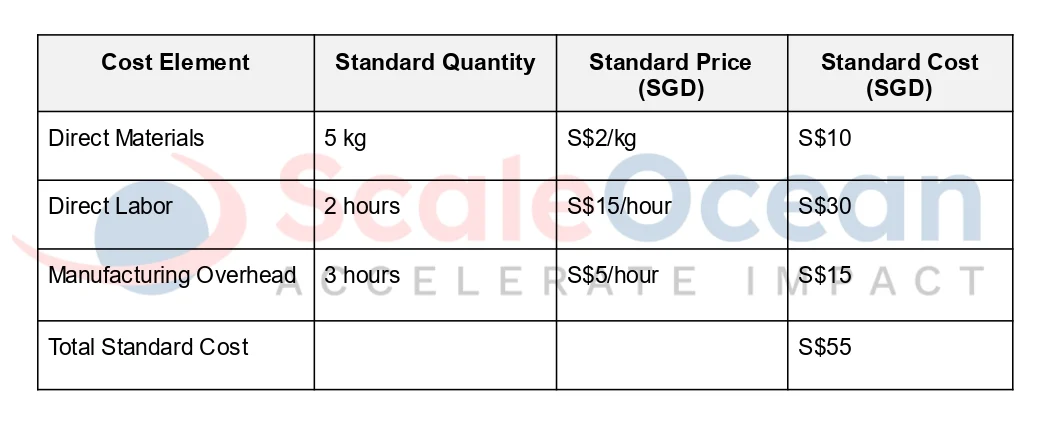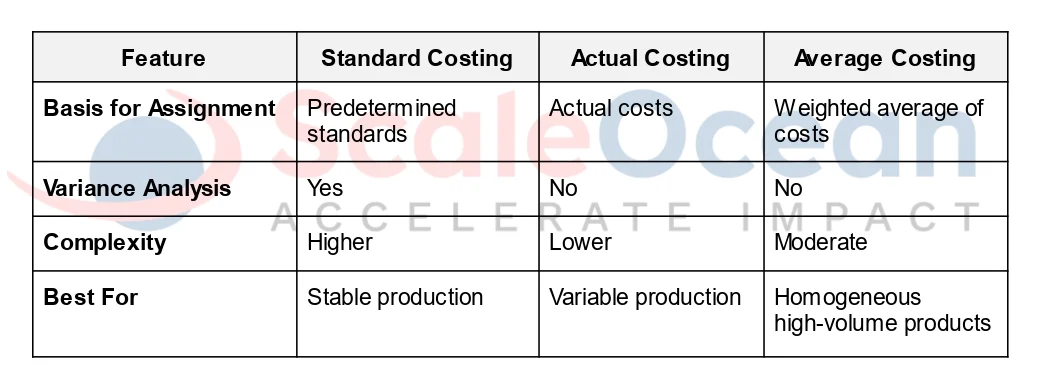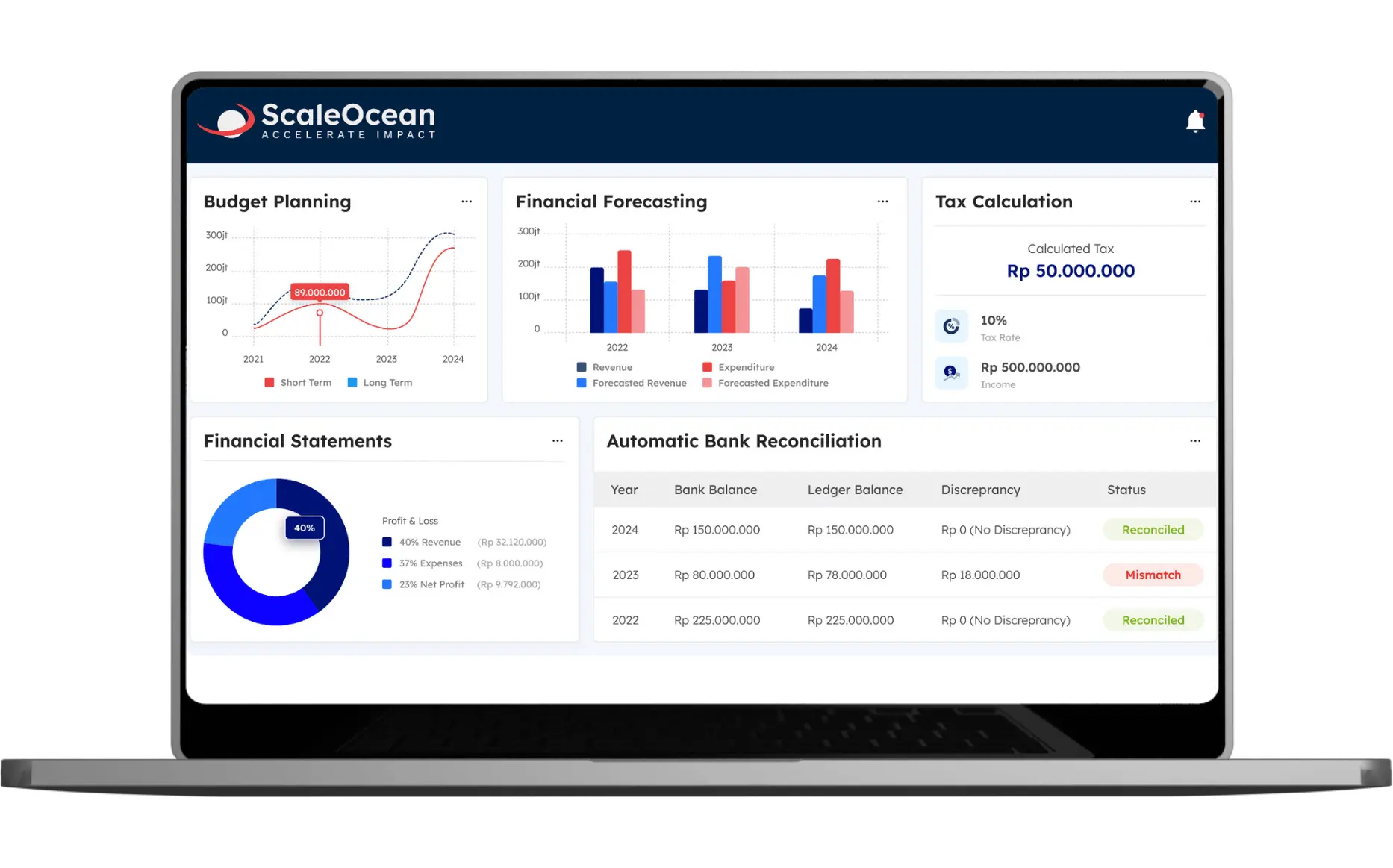Managing production costs is critical for firms to remain competitive. Standard costing is a successful strategy for controlling expenses because it establishes unambiguous, predicted cost targets. According to MTI in Singapore, the manufacturing sector’s unit business cost index increased by only 0.2 percent in 2024, demonstrating effective cost control. This makes understanding standard costing extremely important for organizations today.
This article covers major subjects such as explaining what standard costing is, outlining its primary components, highlighting its benefits, walking you through real-world examples and standard cost estimates, addressing common obstacles, and comparing it to other costing systems. Each component is intended to provide organizations with clear, practical insights and tools for better financial decision-making.
- Standard costing is a method used by businesses to set predetermined costs for production. By leveraging historical data and industry standards, it allows companies to plan, control, and monitor their production efficiency effectively.
- Standard costing provides various benefits, such as improved budgeting, cost control, and performance evaluation. It helps companies in Singapore and worldwide set clear financial goals while promoting better cost management and reducing unnecessary expenses.
- Calculating standard costs involves estimating expenses for materials, labor, and overhead. This process provides a clear financial baseline for budgeting and effective decision-making.
- Integrating standard costs with ScaleOcean’s accounting software automates financial tracking and variance analysis, ensuring accurate, real-time data for better cost control and performance comparison.

What is Standard Costing?
Standard costing is a way by which a corporation establishes a predetermined cost for manufacturing goods or services. These expenses are calculated using historical data, industry averages, and technological studies. Businesses in Singapore and around the world utilize it to plan, control, and monitor production efficiency.
It also provides a uniform structure for tracking and managing production expenses, allowing organizations to remain competitive and profitable. Standard costing is constructed on a few fundamental components that serve as the foundation for proper cost planning:
1. Direct Materials
This is the expected cost of all raw materials required to manufacture a product or provide a service. It includes the purchase price, transportation costs, and any handling fees. Accurate estimates help organizations plan their budgets and avoid production shortages, while also managing overall business expenses effectively.
2. Direct Labor
Direct labor includes the projected cost of employees directly participating in the manufacturing process. This includes pay, overtime, and benefits like insurance or allowances. Proper planning guarantees fair remuneration while keeping production costs in check.
3. Manufacturing Overhead
Manufacturing overhead includes all indirect manufacturing costs that cannot be attributed to individual products. Examples include utility bills, equipment depreciation, maintenance, and factory rent. Tracking these expenses leads to more precise pricing and profitability analysis, especially when used together with an absorption costing approach for allocating all production costs.
Also Read: What is Manufacturing Overhead, How to Calculate, Example
Benefits of Standard Costing

Standard costing provides a number of benefits for financial planning, operational control, and decision-making. It not only helps Singapore businesses create clearer goals, but it also ensures better long-term cost management. The primary benefits include:
1. Enhanced Budgeting and Planning
Standard costing provides a solid financial foundation for developing budgets and projections. Businesses that use predefined costs can set realistic goals and plan for future expenses. This technique also makes it easier to match budgetary objectives to operational capacity.
2. Improved Cost Control
Managers can spot differences immediately by comparing real and standard expenses. Early detection means that corrective action can be implemented before problems worsen. This proactive strategy promotes profitability, reduces wasteful spending, and supports a more accurate manufacturing accounting system.
3. Performance Evaluation
Variance analysis can assist determine how well resources are used. Companies can find opportunities for development by analyzing deviations from the standard. This information contributes to better decision-making and long-term operational efficiency.
4. Simplified Inventory Valuation
Using standard costs simplifies the computation of inventory values and cost of goods sold. It simplifies the process of revising records for fluctuating pricing. This strategy ensures that financial statements are reported faster and more consistently.
5. Cost Reduction
Standard costing highlights inefficiencies, indicating where resources may be squandered. This knowledge enables organizations to alter operations and cut wasteful costs. Over time, this results in more sustainable and cost-effective operations.
How to Calculate Standard Costs
Calculating standard costs assists organizations in estimating the expected costs associated with producing goods or services. This technique establishes a baseline for budgeting and expense control. Understanding how to appropriately calculate these expenses is critical for successful financial planning. The primary components involved are:
1. Direct Material Cost
Direct material cost is the estimated cost of raw materials required to produce one unit of product. Accurately calculating this cost allows businesses to control expenses and price their products competitively. It is critical to analyze all aspects that influence material utilization and pricing. The procedure of calculating direct material cost includes several major steps:
a. Set the standard quantity per unit
Determine how much raw material is required to produce one final product precisely. This should include the bill of materials (BOM), projected yield, and probable scrap or waste during manufacture. Accurate measuring prevents overstocking and manufacturing delays caused by material shortages.
b. Set the standard price per unit
Determine the cost per unit of material by analyzing supplier quotes, contracts, or previous purchase rates. Don’t forget to factor in additional landed costs like freight, customs tariffs, and handling fees to get a complete view of the material expense.
c. Calculate the standard material cost
Multiply the standard quantity by the standard price per unit to calculate the total direct material cost per product unit. This value is used as a baseline for comparing actual material costs and finding discrepancies during production.
2. Direct Labor Cost
The direct labor cost estimates the whole cost of the work required to manufacture one unit of product. Accurate calculation helps to control wage expenses and assures fair compensation for employees. It also helps with budgeting and cost control in production operations, ensuring labor costs are aligned with overall operating cost targets. The computation includes the following critical steps:
a. Estimate Standard Time
Determine the average time a worker takes to create one unit of goods. This should be based on time studies, historical data, or industry standards. Including setup time and any interruptions results in a more realistic and practical estimate.
b. Set Hourly Wage
Set the hourly wage rate for staff directly involved in manufacturing. This rate should include the base salary plus any applicable benefits, overtime, or allowances. Using an exact wage rate reveals the true cost of labor while budgeting.
c. Calculate Labor Cost
To find the total labor cost for producing one unit, multiply the projected time per unit by the hourly wage rate. This statistic is important for budgeting and identifying cost differences when compared to actual labor expenses.
3. Manufacturing Overhead
Manufacturing overhead includes all secondary costs that support the manufacturing process but do not directly relate to a single product. Proper allocation of these costs is critical for understanding the total cost of manufacturing and pricing accuracy. The calculation consists of multiple precise steps:
a. Identify Allocation Base
Select an allocation base, such as machine hours or human hours, that accurately reflects how production uses overhead resources. Link this base directly to the way the company incurs overhead expenses to achieve fair cost allocation. Choosing the appropriate base increases cost accuracy and decision-making.
b. Estimate Total Overhead Costs
Gather and total all indirect production costs, including utilities, depreciation, equipment maintenance, and factory rent. These estimations should be as accurate as feasible to ensure that the overhead rate matches actual costs. Accurate overhead totals reduce cost distortions and facilitate smart budgeting.
c. Calculate Overhead Rate
To calculate the overhead rate per unit of activity, divide the total expected indirect production expenses by the allocation base you chose. This rate indicates how much overhead cost is associated with each machine hour or labor hour used. Calculating the overhead rate enables fair and consistent overhead distribution across goods.
d. Apply Overhead Costs
Multiply the overhead rate by the actual amount of production activity, such as the number of machine or human hours employed. This stage assigns overhead fees to products based on how much resource they actually consume. Applying costs in this manner provides an accurate view of manufacturing costs and profitability.
Also Read: Prepaid Expenses: Definition, Example, and Recording Methods
Example of a Standard Cost Calculation
To further grasp conventional costing, consider a simple calculation. This example divides the cost of making a product into its major components. Below is a sample table that shows the computation in detail:

In this example, producing one unit requires 5 kg of raw materials at SGD 2 per kg, resulting in SGD 10 for materials. Direct labor takes 2 hours at a rate of SGD 15 per hour, contributing SGD 30 to the total. Manufacturing overhead is calculated using 3 hours at SGD 5 per hour, adding SGD 15. When combined, these costs bring the total standard cost to SGD 55.
Challenges of Standard Costing
While standard pricing has numerous benefits, it is not without restrictions. Businesses may face challenges that impair accuracy, adaptability, and overall efficiency. Understanding these potential hurdles is vital for sustaining successful cost management. Examples include:
1. Setting Accurate Standards
Setting precise cost guidelines might be difficult due to volatile market conditions and fluctuating prices. Even modest changes in raw material costs or labor rates might result in considerable variations. Regular market analysis is required to ensure that established standards are realistic and achievable.
2. Maintaining Relevance
If cost guidelines are not reviewed on a regular basis, they will quickly become out of date. Old figures might become inaccurate when technology advances, production methods change, or suppliers alter. Businesses must implement a structured review process to guarantee that these standards remain relevant and reliable over time.
3. Employee Morale
Focusing too heavily on cost variations might have a negative impact on employee motivation. Employee engagement and performance may suffer if they believe the targets are unreasonable. A balanced approach that acknowledges accomplishments while addressing differences might aid in morale.
4. Complexity in Implementation
Standard costing needs comprehensive data collection, meticulous analysis, and, in some cases, modern computing tools. For small enterprises, this process might be resource-intensive. Adequate training and the appropriate tools are required to guarantee a successful and efficient deployment.
Standard Costing vs. Other Costing Methods
Different costing methods offer unique ways to assign and track production costs. Each method has its own strengths, weaknesses, and ideal use cases depending on business needs. The table below highlights the key differences between these three approaches:

When to Use Standard Costing
Standard costing is not appropriate for all types of businesses. It performs best in contexts where expenses and processes are largely consistent across time. Companies can maximize its benefits by knowing the best conditions for its application, which include:
1. Stable Production Processes
This strategy is best suited for industries where production methods are constant and changes are rare. Process variability is low, which means that cost standards can remain accurate for longer. It decreases the need for frequent revisions and minimizes the gap between projected and actual expenditures. Such stability increases the reliability of variance analysis.
2. Mass Production
Standard pricing is ideal for industrial situations with huge volumes of identical items. Because the manufacturing process is repeated, calculating costs becomes easier and more precise. This enables firms to streamline budgeting, track performance, and ensure consistent quality. The predictability of mass production increases the accuracy of cost control.
3. Budgeting and Planning
Standard costing can assist firms in establishing clear financial targets and measuring performance against them. By comparing actual expenses to specified norms, management may discover and correct deviations promptly. This strategy also increases forecast accuracy and resource allocation, ultimately helping improve net sales through better cost management.
How to Implement Standard Costing
Standard costing demands an organized method to assure accuracy and effectiveness. Each phase is intended to connect cost criteria with real-world operations and keep them relevant over time. The method typically includes the following stages:
1. Establish Standards
Begin by obtaining historical cost data and comparing it to industry benchmarks to determine achievable targets. To ensure accuracy, critical departments such as production, procurement, and finance should work together throughout this process. Standards should be based on current market conditions and production capability. A well-defined standard serves as the baseline for performance measurement.
2. Integrate with ScaleOcean Accounting Software

Once standard expenses have been established, including them into ScaleOcean’s accounting software guarantees consistent financial tracking and reporting. The solution automates variance analysis, allowing organizations to quickly detect and resolve cost disparities. With real-time data availability, managers can quickly compare performance against benchmarks, ensuring cost control is accurate and efficient.
ScaleOcean’s accounting software incorporates conventional costing into processes such as procurement, inventory, and payroll, assuring accuracy and data consistency. This automation eliminates manual labor, minimizes errors, and simplifies reporting. Singapore enterprises can take advantage of the CTC award to reduce adoption expenses and request a free demo from our software to witness the real-time benefits. The following is a list of main features from ScaleOcean software:
- All-in-One Solution, Complete modules ensure accurate, automated standard costing across all processes.
- Auto-Pilot Operations, Automates cost calculations and variance analysis for faster insights.
- Multi-Branch Integration, Synchronizes costing data across all branches for consistent reporting.
- Custom Integration, Connects with existing systems to match specific costing workflows.
- Industry Best Practices, Implements standard costing using proven, industry-tested methods.
3. Monitor and Review
Regularly compare actual prices to established benchmarks to find variations or variances. We should address significant differences to determine the underlying causes, whether operational inefficiencies or market shifts. This ongoing monitoring ensures that costs remain under control. It also offers vital insights into process improvement and resource allocation.
4. Update Standards
Cost criteria should be revised on a regular basis to reflect changes in pricing, wages, and production methods. Updating these metrics ensures that they are still relevant and achievable in the current business context. Ignoring updates may result in outdated benchmarks that misguide decision-making. Timely adjustments maintain the costing system accurate and efficient.
Implementing Standard Costing: Practical Examples
Standard costing can be used across industries to improve financial management and operational efficiency. These real-world examples demonstrate how various industries benefit from setting preset expenses and analyzing deviations. Here are two practical examples:
1. Manufacturing Sector
Prior to beginning manufacturing, a car manufacturer specifies standard costs for components such as engines, tires, and electronics. These costs are compared to real expenses to determine any discrepancies that may suggest inefficiency. This allows the organization to change its buying methods, optimize operations, and improve cost management for future manufacturing runs.
2. Service Industry
A hotel chain establishes regular pricing for products such as room amenities, housekeeping services, and maintenance activities. Variance analysis allows management to track expenses and identify variances that may have an impact on profitability. According to Credence Research, with the hospitality market in Singapore projected to grow at 5.2% annually through 2032, such practices help hotels better allocate resources, maintain quality service, and keep financial performance on track.
Conclusion
Standard costing is an effective strategy for controlling costs, improving budget accuracy, and assessing performance, particularly in stable production environments. It lays you a clear framework for tracking spending and identifying areas for improvement. Businesses can keep tighter financial control by comparing actual costs to pre-determined benchmarks. This strategy also helps with decision-making by giving consistent and dependable cost data.
While the benefits are great, businesses must also acknowledge its limitations in order to avoid misleading cost data. Standards should be revised on a regular basis to reflect changes in the market and operations. Outdated statistics hinder efficacy, but ScaleOcean’s accounting software automates updates and variance tracking, ensuring standard pricing is accurate and current.
FAQ:
1. What do you mean by standard costing?
Standard costing is an accounting approach where a business assigns preset costs to materials, labor, and overhead. These set figures work as reference points to compare with actual spending, making it easier to assess efficiency, manage costs, and create accurate budgets.
2. What are the four types of standard costing?
1. Ideal Standards – Expect flawless efficiency without any losses or delays.
2. Currently Attainable Standards – Represent achievable performance under typical working conditions.
3. Basic Standards – Stay unchanged for extended periods, useful for trend tracking.
4. Normal Standards – Use historical average performance as the benchmark.
3. What are the standard costs?
Standard costs are predetermined amounts estimated for producing a product or delivering a service, covering materials, labor, and overhead. They serve as target values to compare with actual spending, aiding in variance detection, budget control, and operational evaluation.
4. How do you calculate standard cost?
1. Define the standard quantity for each cost element: materials, labor, and overhead.
2. Set the standard rate or price for each element.
3. Multiply the quantity by the rate for each category.
4. Sum the totals to find the expected cost per unit under standard conditions.







 PTE LTD..png)
.png)

.png)








.png)
.png)
















